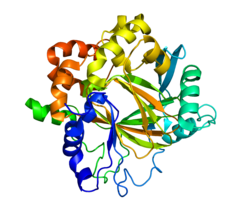Demethylases are enzymes that remove methyl (CH3) groups from nucleic acids, proteins (particularly histones), and other molecules. Demethylases are important epigenetic proteins, as they are responsible for transcriptional regulation of the genome by controlling the methylation of DNA and histones, and by extension, the chromatin state at specific gene loci.

Lysine-specific histone demethylase 1A (LSD1) also known as lysine (K)-specific demethylase 1A (KDM1A) is a protein in humans that is encoded by the KDM1A gene. LSD1 is a flavin-dependent monoamine oxidase, which can demethylate mono- and di-methylated lysines, specifically histone 3, lysines 4 and 9. This enzyme can have roles critical in embryogenesis and tissue-specific differentiation, as well as oocyte growth. KDM1A was the first histone demethylase to be discovered though more than 30 have been described.

Polycomb protein SUZ12 is a protein that in humans is encoded by the SUZ12 gene.

Lysine-specific demethylase 5A is an enzyme that in humans is encoded by the KDM5A gene.

Lysine-specific demethylase 4A is an enzyme that in humans is encoded by the KDM4A gene.

Bifunctional arginine demethylase and lysyl-hydroxylase JMJD6 is an enzyme that in humans is encoded by the JMJD6 gene.

Lysine-specific demethylase 2A (KDM2A) also known as F-box and leucine-rich repeat protein 11 (FBXL11) is an enzyme that in humans is encoded by the KDM2A gene. KDM2A is a member of the superfamily of alpha-ketoglutarate-dependent hydroxylases, which are non-haem iron-containing proteins.

Lysine-specific demethylase 3B is an enzyme that in humans is encoded by the KDM3B gene. KDM3B belongs to the alpha-ketoglutarate-dependent hydroxylase superfamily.

Histone-lysine N-methyltransferase 2D (KMT2D), also known as MLL4 and sometimes MLL2 in humans and Mll4 in mice, is a major mammalian histone H3 lysine 4 (H3K4) mono-methyltransferase. It is part of a family of six Set1-like H3K4 methyltransferases that also contains KMT2A, KMT2B, KMT2C, KMT2F, and KMT2G.

Lysine-specific demethylase 5B also known as histone demethylase JARID1B is a demethylase enzyme that in humans is encoded by the KDM5B gene. JARID1B belongs to the alpha-ketoglutarate-dependent hydroxylase superfamily.

Lysine-specific demethylase 4B is an enzyme that in humans is encoded by the KDM4B gene. KDM4B belongs to the alpha-ketoglutarate-dependent hydroxylase superfamily.

Lysine-specific demethylase 6A also known as Ubiquitously transcribed tetratricopeptide repeat, X chromosome (UTX), is a protein which in humans is encoded by the KDM6A gene. It belongs to the 2-oxoglutarate (2OG)-dependent dioxygenase superfamily.

Lysine-specific demethylase 4C is an enzyme that in humans is encoded by the KDM4C gene.

Euchromatic histone-lysine N-methyltransferase 1, also known as G9a-like protein (GLP), is a protein that in humans is encoded by the EHMT1 gene.

The human KDM2B gene encodes the protein lysine (K)-specific demethylase 2B.

Lysine (K)-specific demethylase 1B is a protein that in humans is encoded by the KDM1B gene.

Lysine demethylase 3A is a protein that in humans is encoded by the KDM3A gene.

Lysine demethylase 6B is a protein that in humans is encoded by the KDM6B gene.

Lysine demethylase 7A is a protein that in humans is encoded by the KDM7A gene.

Yi Zhang is a Chinese-American biochemist who specializes in the fields of epigenetics, chromatin, and developmental reprogramming. He is a Fred Rosen Professor of Pediatrics and Professor of Genetics at Harvard Medical School, a Senior Investigator of Program in Cellular and Molecular Medicine at Boston Children's Hospital, and an Investigator of the Howard Hughes Medical Institute. He is also an Associate Member of the Harvard Stem Cell Institute, as well as the Broad Institute of MIT and Harvard. He is best known for his discovery of several classes of epigenetic enzymes and the identification of epigenetic barriers of SCNT cloning.





















